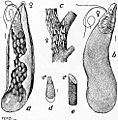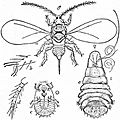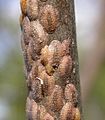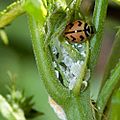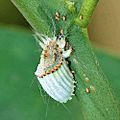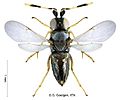Scale insect facts for kids
Quick facts for kids Scale insect |
|
|---|---|
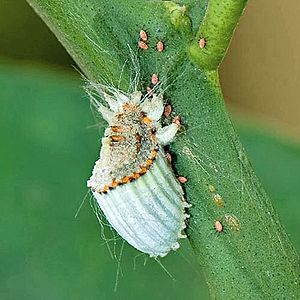 |
|
| Adult cottony cushion scale (Icerya purchasi) with young crawlers | |
| Scientific classification | |
| Kingdom: | |
| Phylum: | |
| Class: | |
| Order: | |
| Suborder: |
Sternorrhyncha
|
| Superfamily: |
Coccoidea
|
Scale insects are tiny bugs that belong to a group called Hemiptera. They are part of a larger family known as Coccoidea. There are around 8,000 different kinds, or species, of scale insects known today.
These insects are like tiny plant "vampires." They live on the outside of plants and are called ectoparasites. They use their special mouthparts to poke into the plant and suck out its sap.
Adult female scale insects usually don't move at all. They stay attached to the plant they are feeding on for their whole lives. They make a waxy layer over their bodies to protect themselves. This waxy covering makes them look a bit like fish scales, which is how they got their name!
Contents
Differences Between Males and Females
Male and female scale insects look very different from each other. This is called sexual dimorphism. Female scale insects keep their young, or juvenile, shape even when they are grown up and can have babies. This is a special condition known as neoteny.
Adult male scale insects often have wings, but this depends on their species. They do not eat at all once they are adults. Sadly, they only live for a day or two.
Life Cycle and Reproduction
The way scale insects have babies is very different depending on the species. Some species can even be both male and female at the same time, which is called hermaphroditism. Others can have babies without a male, a process known as parthenogenesis.
When scale insects are born, they are called "crawlers." These tiny crawlers have legs and can move around. However, if a crawler is female, she will soon lose the use of her legs. She will then stay in one spot for the rest of her life. Only the male crawlers keep their legs. They use them to find females for mating.
Controlling Scale Insects
Many types of scale insects are a big problem for farmers and gardeners. They are known as serious crop pests. Their waxy covering makes it hard to get rid of them with regular insecticides. However, there are ways to control them.
- Horticultural oils: These special oils can suffocate the insects by blocking their breathing holes.
- Systemic pesticides: These chemicals are absorbed by the plant. When the scale insect sucks the plant's sap, it gets poisoned.
- Biological control: This method uses other living things to fight the pests. Tiny parasitoid wasps lay their eggs inside the scale insects. Also, ladybugs (Coccinellid beetles) love to eat scale insects.
- Insecticidal soap: This special soap can also be used to kill scale insects.
Images for kids
-
Life-cycle of the apple scale, Mytilaspis pomorum. a) underside of scale showing female and eggs, x24 b) scale upperside, x24 c) female scales on twig d) male scale, x12 e) male scales on twig
-
Fossil of the pseudococcid mealybug Electromyrmococcus (in the jaws of an ant) in Miocene Dominican amber
-
Adult female cottony cushion scale (Icerya purchasi) with young crawlers. The species is a major commercial pest of crops such as Citrus fruits.
-
The tiny parasitic wasp Anagyrus lopezi, a highly effective biological control of the cassava mealybug
-
Collecting scale insects from a prickly pear for a dyestuff, cochineal, 1777
-
Coronation cloak of King Roger II of Sicily, 1133. Silk scarlet cloth dyed with kermes, made from female Kermes scales
See also
 In Spanish: Coccoidea para niños
In Spanish: Coccoidea para niños




